|
|
|
 |

 |
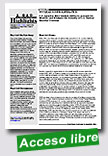 |
Nuclear Nonproliferation: U.S. Agencies Have Limited Ability to Account for, Monitor, and Evaluate the Security of U.S. Nuclear Material Overseas
Government Accountability Office (GAO-US), September 8, 2011, 68 p.
DOE, NRC, and State are not able to fully account for U.S. nuclear material overseas that is subject to nuclear cooperation agreement terms because the agreements do not stipulate systematic reporting of such information, and there is no U.S. policy to pursue or obtain such information. U.S. nuclear |
cooperation agreements generally require that partners report inventory information upon request, however, DOE and NRC have not systematically sought such data. DOE and NRC do not have a comprehensive, detailed, current inventory of U.S. nuclear material--including weapon-usable material such as highly enriched uranium (HEU) and separated plutonium--overseas that includes the country, facility, and quantity of material. In addition, NRC and DOE could not fully account for the current location and disposition of U.S. HEU overseas in response to a 1992 congressional mandate. U.S. agencies, in a 1993 report produced in response to the mandate, were able to verify the location of 1,160 kilograms out of 17,500 kilograms of U.S. HEU estimated to have been exported. DOE, NRC, and State have established annual inventory reconciliations with five U.S. partners, but not the others it has transferred material to or trades with. Nuclear cooperation agreements do not contain specific access rights that enable DOE, NRC, or State to monitor and evaluate the physical security of U.S. nuclear material overseas, and the United States relies on its partners to maintain adequate security. In the absence of access rights, DOE's Office of Nonproliferation and International Security, NRC, and State have conducted physical protection visits to monitor and evaluate the physical security of U.S. nuclear material at facilities overseas when permitted. However, the agencies have not systematically visited countries believed to be holding the highest proliferation risk quantities of U.S. nuclear material, or systematically revisited facilities not meeting international physical security guidelines in a timely manner. Of the 55 visits made from 1994 through 2010, U.S. teams found that countries met international security guidelines approximately 50 percent of the time. DOE has taken steps to improve security at a number of facilities overseas that hold U.S. nuclear material but faces constraints. DOE's Global Threat Reduction Initiative (GTRI) removes U.S. nuclear material from vulnerable facilities overseas but can only bring back materials that have an approved disposition pathway and meet the program's eligibility criteria. GTRI officials told GAO that, of the approximately 17,500 kilograms of HEU exported from the United States, 12,400 kilograms are currently not eligible for return to the United States. Specifically, GTRI reported that over 10,000 kilograms of U.S. HEU are believed to be in fuels from reactors in Germany, France, and Japan that have no disposition pathways in the United States and are adequately protected. In addition, according to GTRI, 2,000 kilograms of transferred U.S. HEU are located primarily in European Atomic Energy Community countries and are currently in use or adequately protected. GAO suggests, among other things, that Congress consider directing DOE and NRC to compile an inventory of U.S. nuclear material overseas. DOE, NRC, and State generally disagreed with GAO's recommendations, including that they conduct annual inventory reconciliations with all partners, stating they were unnecessary. GAO continues to believe that its recommendations could help improve the accountability of U.S. nuclear material in foreign countries.
Extraído de:
http://www.gao.gov/products/GAO-11-920
|
 |
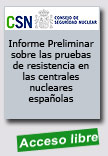 |
Informe Preliminar sobre las pruebas de resistencia en las centrales nucleares españolas
Consejo de Seguridad Nuclear, 15 septiembre 2011, 102 p.
Este informe preliminar, realizado por las direcciones técnicas del Consejo de Seguridad Nuclear, contiene la evaluación de los informes preliminares presentado por los titulares de las centrales nucleares españolas. El contenido del documento debe considerarse preliminar y el informe definitivo será objetode aprobación por el Pleno del Consejo de sEguridad Nuclear, conforme a los plazos establecidos para su remisión antes del 31 de diciembre de 2011.
Informe
|
Extraído de:
http://www.csn.es/index.php?option=com_content&
view=article&id=18345&Itemid=760%E2%8C%A9=es |
 |
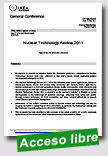 |
Nuclear Technology Review 2011
IAEA, 2010, 41 p.
This review - issued every two years and updated annually - reports on the global status and trends in fields of nuclear science and technology. Topics covered include nuclear power development, including innovative reactors and fuel cycle approaches; nuclear applications in fields of health, agriculture, water, and other areas; nuclear information and knowledge management; and issues of sustainable development in which nuclear technologies can play an important role. |
Extraído de:
http://www.iaea.org/Publications/Reports/index.htm
|
 |
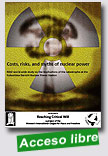 |
The report is the collaborative work of non-governmental researchers, scientists, and activists. It was released on 11 September 2011, six months after the disaster at Fukushima and in advance of the high-level meeting on nuclear safety and security that UN Secretary-General Ban Ki-moon will convene at the United Nations on 22 September. Its release is also timed to coincide with the UN system-wide study of the implications of Fukushima commissioned by Ban. |
Inspired by the UN Secretary-General’s call for a global debate on nuclear energy, Reaching Critical Will, a project of the Women’s International League for Peace and Freedom, coordinated an international civil society study in order to provide non-government perspectives of the range of issues related to nuclear power. This report includes civil society analysis of nuclear power infrastructure and government policies from around the world. It also articulates arguments against the common myths of nuclear power in its relationship to safety, the environment, renewable energy, climate change, economics, and more.
Home-page | Full report
Extraído de:
http://www.ukwilpf.org/new-resource-from-reaching-critical-will |
 |
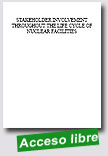 |
Stakeholder Involvement Throughout the Life Cycle of Nuclear Facilities
IAEA Nuclear Energy Series, 2011, 42 p.
This report demonstrates the importance of stakeholder involvement throughout the life cycle of all nuclear facilities; including operating reactors, temporary spent fuel storage facilities and final radioactive waste repositories and follows what is defined in the IAEA Safety Standards GS-R-3 where the stakeholders’ expectations (identified as “interested parties” in GS-R-3) shall be taken into consideration “in the activities and |
interactions in the processes of the management system, with the aim of enhancing the satisfaction of interested parties while at the same time ensuring that safety is not compromised”.
This report explains how involving stakeholders in decision making processes, even for those stakeholder groups that do not have a direct role in making those decisions, can enhance public confidence in the application of nuclear science and technology. In addition, this report presents general guidance on stakeholder involvement. It does not provide detailed procedures for developing and implementing stakeholder involvement programmes, and specifics regarding stakeholder involvement for particular types of nuclear facilities. However, this publication references reports that provide such details. This publication provides assistance to those responsible for planning, designing, constructing, operating or decommissioning a nuclear facility. In addition, regulatory organizations and other authorities overseeing nuclear activities or managing nuclear facility licensing processes are often seen as the main source of independent information for the general public; therefore, stakeholder involvement can demonstrate capability and trustworthiness of regulatory organizations as well.
The role of stakeholder involvement at different stages of a facility’s life cycle is discussed, with suggestions on developing the components of a comprehensive stakeholder involvement plan. Included is guidance on focusing communication with certain stakeholders, applying various stakeholder involvement techniques and introducing messages such as ethical issues in support of nuclear facilities, including the need for sustainable energy resources and responsibility to future generations.
The printed version of the report does not include examples. Instead, the Nuclear Communicator’s Toolbox (http://www.iaea.org/nuccomtoolbox/index.html) will store good practices and lessons learnt that can be accessible to all readers and will be updated on a regular basis based on the new case studies that are submitted by users to the following email address: toolbox@iaea.org.
Extraído de:
http://www-pub.iaea.org/MTCD/Publications/PDF/P1520_web.pdf |
 |
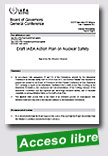 |
Draft IAEA Action Plan on Nuclear Safety
IAEA, 5 September 2011, 7 p.
In accordance with paragraphs 23 and 24 of the Declaration adopted by the Ministerial Conference on Nuclear Safety held on 20-24 June 2011, the Director General was requested to prepare and present to the Board of Governors and the General Conference at their September 2011 meetings a report on the Ministerial Conference and a draft Action Plan, building on the Ministerial Declaration, the conclusions and recommendations of the working sessions of the Ministerial Conference and
|
the expertise and knowledge available therein, and to facilitate consultations among Member States on the draft Action Plan.
The attached draft Action Plan is the result of an extensive process of consultations with Member States and responds to the request contained in the Ministerial Declaration.
En español
Extraído de:
http://www.iaea.org/About/Policy/GC/GC55/Documents/gc55-14.pdf
|
 |
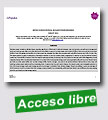
|
British Science Festival: Nuclear Power ResearchPopulus/British Science Association, August 2011, 13 p.
Populus interviewed a random sample of 2,050 adults online between 26th August 2011 and 29th August 2011. Interviews were conducted across Great Britain and the results have been weighted to be representative of all adults. Populus is a member of the British Polling Council and abides by its rules.
Full data
|
Extraído de:
http://www.britishscienceassociation.org/NR/rdonlyres/
E80EF06C-2B34-45B4-B3D5-C42FAC561BCD/0/ExecSummaryBritishScienceFestivalNuclear
PowerAugust2011.pdf |
 |
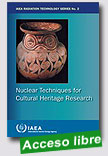 |
Nuclear Techniques for Cultural Heritage Research
IAEA Radiation Technology Series, 2011, 205 p.
This publication highlights the role of nuclear techniques for cultural heritage research. As cultural heritage objects are frequently unique and non-replaceable, non-destructive techniques are mandatory and, hence, nuclear techniques have a high potential to be applied to study these valuable objects. The target readers of this publication are scientists and professionals involved in development and application of nuclear techniques, experts in the field of restoration, conservation and classification of artefacts, as well as museum curators and archaeologists. Students in these various fields may also find this book valuable. |
Extraído de:
http://www-pub.iaea.org/books/IAEABooks/8477/Nuclear-Techniques-for-Cultural-Heritage-Research
|
 |
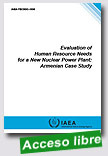 |
Evaluation of Human Resource Needs for a New Nuclear Power Plant: Armenian Case Study
IAEA TECDOC, 2011, 99 p.
This publication draws on the experience of an IAEA Technical Cooperation project using Armenia as an example to look at the tasks linked to the management of human resources that will be required by a country planning a new nuclear power plant. It summarizes the major findings of the project, and identifies and analyses the demand in human resources at all stages of construction of a new nuclear power plant unit. This includes in detail the issues of selection of an option for construction, |
standard processes associated with construction work, customer actions at various stages leading up to commissioning, means, conditions and requirements for the training of specialists, and assessments of various projects being considered for implementation. The target readers of the publication are governmental officials and officers of ministries in Member States planning to embark upon or expand a nuclear power programme, as well as national utilities and regulators.
Extraído de:
http://www-pub.iaea.org/books/IAEABooks/8549/Evaluation-of-Human-Resource-Needs-for-a-New-Nuclear-Power-Plant-Armenian-Case-Study |
 |
| 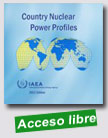
|
Country Nuclear Power Profiles - 2011 Edition
IAEA, 2011, s. p.
The Country Nuclear Power Profiles compiles background information on the status and development of nuclear power programs in Member States. It consists of organizational and industrial aspects of nuclear power programs and provides information about the relevant legislative, regulatory, and international framework in each country. Its descriptive and statistical overview of the overall economic, energy, and
|
electricity situation in each country, and its nuclear power framework is intended to serve as an integrated source of key background information about nuclear power programs in the world.
The preparation of Country Nuclear Power Profiles (CNPP) was initiated in 1990s. It responded to a need for a database and a technical publication containing a description of the energy and economic situation, the energy and the electricity sector, and the primary organizations involved in nuclear power in IAEA Member States.
This is the 2011 edition issued on CD-ROM and Web pages. It updates the country information for 50 countries. The CNPP is updated based on information voluntarily provided by participating IAEA Member States. Participants include the 29 countries that have operating nuclear power plants, as well as 21 countries having past or planned nuclear power programmes (Bangladesh, Belarus, Chile, Egypt, Ghana, Indonesia, the Islamic Republic of Iran, Italy, Jordan, Kazakhstan, Kuwait, Lithuania, Morocco, Nigeria, Philippines, Poland, Syrian Arab Republic, Thailand, Tunisia, Turkey and Vietnam).
For the 2011 edition, 23 countries provided updated or new profiles. For the other countries, the IAEA updated the profile statistical tables on nuclear power, energy development, and economic indicators based on information from IAEA and World Bank databases.
Extraído de:
http://www-pub.iaea.org/MTCD/Publications/PDF/CNPP2011_CD/pages/index.htm
|
|
|
|
|
|
|
